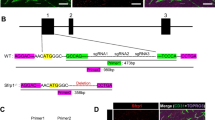Abstract
To study the effect of recombinant adeno-associated virus (rAAV) vector bearing small inference RNA (siRNA) targeting hypoxia inducible factor 1α (HIF-1α) combined l-ascorbate on pancreatic tumors in athymic mice primarily. A cassette encoding siRNA targeting HIF-1α mediated by rAAV was constructed, giving rAAV-siHIF. In vitro, rAAV-hrGFP, rAAV-siHIF and l-ascorbate which were used alone or in combination were delivered to exponentially growing MiaPaCa2 cells. Then, we examined the expression of HIF-1α mRNA and protein, the secretion of VEGF in MiaPaCa2 cells under hypoxic condition with Real-time PCR, Western Blot, ELISA, respectively. In vivo, MiaPaCa2 cells were inoculated subcutaneously on the back of nude mice. Nude mice with xenograft tumor were randomly divided into equal groups and were injected with rAAV-hrGFP or rAAV-siHIF or were fed with l-ascorbate. Then, we measured the size of tumor every 3 days and drew a tumor growth curve. After 30 days, all mice were sacrificed and the tumors were dissected. At last, we examined the expression of HIF-1α, VEGF and CD34 by immunohistochemistry and counted micro-vessel density (MVD). In vitro, we found that rAAV-siHIF could inhibit the expression of HIF-1α mRNA and protein in MiaPaCa2 human pancreatic cancer cells but l-ascorbate could only restrain the expression of HIF-1α protein. Moreover, rAAV-siHIF and l-ascorbate could all inhibit the secretion of vascular VEGF. In vivo, we found that rAAV-siHIF could inhibit the growth of nude mice xenograft tumor and the expression of HIF-1α and VEGF and MVD while l-ascorbate can only inhibit the growth of xenograft tumor in the early and middle stage. These results suggest that rAAV-siHIF and l-ascorbate can inhibit the growth of nude mice xenograft tumor and HIF-1α could be a target of pancreatic cancer genetic and pharmacological therapy.




Similar content being viewed by others
References
Yin T, Wang C, Liu T et al (2007) Expression of snail in pancreatic cancer promotes metastasis and chemoresistance. J Surg Res 141:196–203
Brizel DM, Scully SP, Harrelson JM et al (1996) Tumor oxygenation predicts for the likelihood of distant metastasis in human soft tissue sarcoma. Cancer Res 56:941–943
Semenza GL (2003) Targeting HIF-1 for cancer therapy. Nature Rev 3:721–732
Mazure NM, Brahimi-Horn MC, Berta MA et al (2004) HIF-1: master and commander of the hypoxic world. A pharmacological approach to its regulation by siRNAs. Biochem Pharmacol 68:971–980
Frelin C, Ladoux A, D’angelo G (2000) Vascular endothelial growth factors and angiogenesis. Ann Endocrinol 61:70–74
Forsythe JA, Jiang BH, Iyer NV et al (1996) Activation of vascular endothelial growth factor gene transcription by hypoxia-inducible factor 1. Mol Cell Biol 16:4604–4613
Sivridis E, Giatromanolaki A, Gatter KC et al (2002) Association of hypoxia-inducible factors 1alpha and 2alpha with activated angiogenic pathways and prognosis in patients with endometrial carcinoma. Cancer 95:1055–1063
Yihai C (1999) Therapeutic potentials of angiostatin in the treatment of cancer. Haematologica 84:643–650
Zhong H, De Marzo AM, Laughner E et al (1999) Overexpression of hypoxia-inducible factor-1a in common human cancers and their metastases. Cancer Res 59:5830–5835
Masson N, Willam C, Maxwell PH et al (2001) Independent function of two destruction domains in hypoxia-inducible factor-alpha chains activated by prolyl hydroxylation. EMBO J 20:5197–5206
Knowles HJ, Raval RR, Harris AL et al (2003) Effect of ascorbate on the activity of hypoxia-inducible factor in cancer cells. Cancer Res 63:1764–1768
Tomar RS, Matta H, Chaudhary PM (2003) Use of adeno-associated viral vector for delivery of small interfering RNA. Oncogene 22:5712–5715
Stilwell JL, Samulski RJ (2003) Adeno-associated virus vectors for therapeutic gene transfer. Biotechniques 34:148–150
Zamore PD (2001) RNA interference: listening to the sound of silence. Nat Struct Boil 8:746–751
Wu ZJ, Wu XB, Cao H et al (2001) A novel method for purification of recombinant adeno-associated virus vectors in large-scale. Chin Sci Bull 31:423–430
Weidner N, Semple JP, Welch WR et al (1991) Tumor angiogenesis andmetastasis: correlation in invasive breast carcinoma. New Eng J Med 324:1–8
Vaupel P, Mayer A (2007) Hypoxia in cancer: significance and impact on clinical outcome. Cancer Metastasis Rev 26:225–239
Semenza GL (2000) HIF-1: mediator of physiological and pathophysiological responses to hypoxia. J Appl Physiol 88:1474–1480
Wang F, Li SS, Segersvard R, Strommer L et al (2007) Hypoxia inducible factor-1 mediates effects of insulin on pancreatic cancer cells and disturbs host energy homeostasis. Am J Pathol 170:469–477
Lu H, Forbes RA, Verma A (2002) Hypoxia-inducible factor 1 activation by aerobic glycolysis implicates the Warburg effect in carcinogenesis. J Bio Chem 26:23111–23115
Buchler P, Reber HA, Buchler M et al (2003) Hypoxia-inducible factor 1alpha regulates vascular endothelial growth factor expression in human pancreatic cancer. Pancreas 26:55–64
André T, Chastre E, Kotelevets L et al (1998) Tumoral angiogenesis: physiopathology, prognostic value and therapeutic perspectives. Rev Med Interne 19:904–913
Folkman J (2002) Role of angiogenesis in tumor growth and metastasis. Semin Oncol 29:15–18
Yang ZF, Poon RT, To J et al (2004) The potential role of hypoxia inducible factor 1 alpha in tumor progression after hypoxia and chemotherapy in hepatocellular carcinoma. Cancer Res 64:5496–5503
Acknowledgments
We thank Dr. Wenjie Wei (Pennsylvania University), Dr. Yihai Cao and Dr. Feng Wang (Karolinska Institute) for insightful advice. This work was supported by the Foundation of Tianjin Nature Science (Grant 05YFSYSF01300).
Author information
Authors and Affiliations
Corresponding author
Rights and permissions
About this article
Cite this article
Chen, C., Sun, J., Liu, G. et al. Effect of Small Interference RNA Targeting HIF-1α Mediated by rAAV Combined l-Ascorbate on Pancreatic Tumors in Athymic Mice. Pathol. Oncol. Res. 15, 109–114 (2009). https://doi.org/10.1007/s12253-008-9063-7
Received:
Accepted:
Published:
Issue Date:
DOI: https://doi.org/10.1007/s12253-008-9063-7




